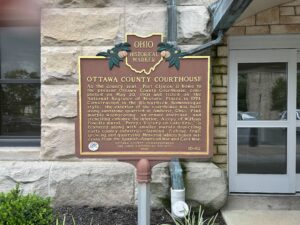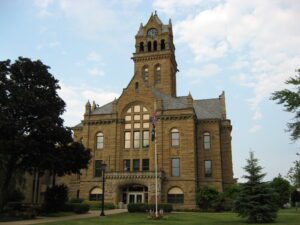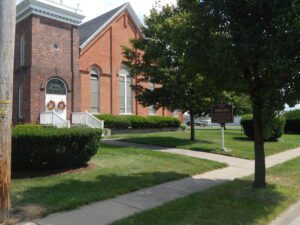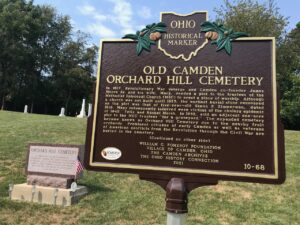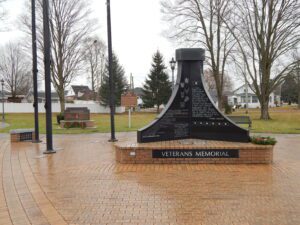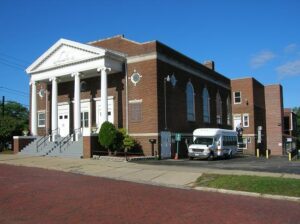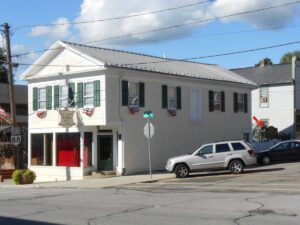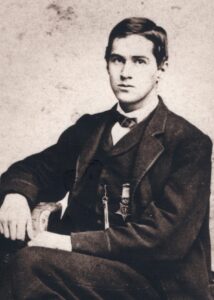, OH
As the county seat. Port Clinton is home to the present Ottawa County Courthouse, completed on May 20, 1901 and listed on the National Register of Historic Places in 1974. Constructed in the Richardson Romanesque style, the exterior of the courthouse was built using sandstone quarried at Amherst, Ohio. Pink marble wainscoting, an ornate staircase, and stenciling enhance the interior. A copy of William Powell’s mural, “Perry’s Victory on Lake Erie,” is featured along with smaller murals depicting early county industries–farming, fishing, fruit growing, and quarrying. Memorial tablets honor veterans from the Spanish-American War and Civil War.
, OH
As the county seat, Port Clinton is home to the present Ottawa County Courthouse, completed on May 20, 1901 and listed on the National Register of Historic Places in 1974. Constructed in the Richardson Romanesque style, the exterior of the courthouse was built using sandstone quarried at Amherst, Ohio. Pink marble wainscoting, an ornate staircase, and stenciling enhance the interior. A copy of William Powell’s mural, “Perry’s Victory on Lake Erie,” is featured along with smaller murals depicting early county industries – farming, fishing, fruit growing, and quarrying. Memorial tablets honor veterans from the Spanish-American War and Civil War.
, OH
The Rev. Jacob Ward founded the Brunswick Methodist Episcopal Church in April 1817 with 13 members: Rhoda Stow, John and Lucy Stearns, John and Hannah Hulet, Samuel and Sarah Tillotson, Thomas and Phoebe Stearns, Solomon and Polly Harvey, Lydia Crittenden, and Olivia Ashley. In 1830, John and Lucy Stearns donated land for a cemetery, which included space for a church. A new church was completed in 1872. Bricks used for the building were fired locally and the first windows were glazed with clear glass and protected by shutters. In 1916, the church was extensively remodeled and redecorated. Stained glass replaced the clear glass, the church bell was relocated to the newly-added tower, and the main entrance was moved from the center of the building to the vestibule in the tower. (Continued on other side)
, OH
In 1817, Revolutionary War veteran and Camden co-founder James Moore Sr. and his wife, Mary, deeded a plot to the trustees of the Methodist Episcopal Church (MEC) to erect a place of worship. Although a church was not built until 1825, the earliest burial stone recovered on the plot was that of five-year-old Simon P. Zimmerman, dated 1818. Many subsequently interred were victims of the cholera epidemic of 1849. Felix and Rachel Marsh, in 1852, sold an adjacent one-acre plot to the MEC trustees “for a graveyard.” The expanded cemetery became known as Orchard Hill Cemetery due to the nearby fruit orchards. Prominent citizens of early Camden as well as veterans of American conflicts from the Revolution through the Civil War are buried in the cemetery. (Continued on the other side)
, OH
Local views on the Vietnam War mirrored national attitudes of pride and confusion. Piqua citizens participated in the “Letters for Life” campaign in 1970 for prisoners of war. Piqua Daily Call assistant news editor James W. DeWeese traveled to Paris in a frustrated attempt to deliver the letters to the Hanoi Peace delegation. The state activated the local Ohio National Guard unit in 1970 to help suppress anti-Vietnam student rioting in Columbus. The military conflict came home in 1966 when William Pitsenbarger became the first of eleven men from Piqua to die in Vietnam. In 1967, Piqua High School graduate Air Force Major William J. Baugh was shot down over North Vietnam and taken prisoner. He remained a P.O.W. until 1973.
, OH
This church, founded in 1866, is the oldest Black congregation in Akron. After worshiping in several locations, the congregation held a fund-raiser to help finance the construction of a permanent home. The person collecting the most money had the privilege of renaming the church. That honor went to Mrs. Belle (Smith) Wesley. Completed in 1928, the current structure is a Neo-Classical Revival style building, featuring a classical pedimented portico, or porch, and four distinctive ionic columns. An education wing was added in 1963 by the late Rev. Dr. E. E. Morgan, Jr. Akron Black architects Herbert L. Wardner and John O. Somerville designed the church, and then a Black contractor, Samuel Plato, completed the structure. The church has long been a vital religious and social focal point for Akron’s Black community. The local chapter of the National Association for the Advancement of Colored People (NAACP) was organized at Wesley Temple. Placed on the National Register of Historic Places 3/19/94.
, OH
Evidence abounds that Garrettsville was at the center of the maple industry in Ohio from the 1880s into the twentieth century. In 1881, Garrettsville held the first ever-professional association of maple syrup/sugar producers, a tradition that continued annually into the early 1900s. The one square mile of Garrettsville was home to several maple syrup canneries in the 1880s and to syrup evaporator manufacturers. It was also the home to Lifesavers candy, originally a maple sugar based company. In 1893, Garrettsville sent a contingent of maple syrup and sugar producers to the Columbian Exhibition at the Worlds Fair in Chicago. In that year, a Garrettsville area farmer was awarded the first place medal for the best maple sugar in the world.
, OH
Ovid Wellford Smith, aged 16, enlisted in the 2nd Ohio Volunteer Infantry as James Smith. He volunteered for the 1862 “Andrews’ Raid” mission to destroy Confederate supply lines. Enroute Smith became ill and was detained near Huntsville, Alabama, prior to the April 12 capture of “The General” locomotive at Big Shanty, Georgia. He escaped and made his way back to rejoin his Army unit. On July 6, 1864, Smith and 5 other raiders were awarded the Medal of Honor. He mustered out October 1864 at the rank of corporal, after participating in the Battles of Chickamauga, Chattanooga, and Missionary Ridge.


